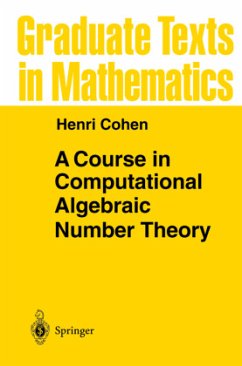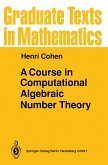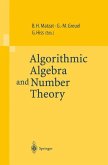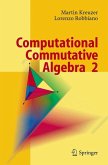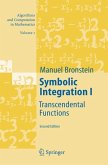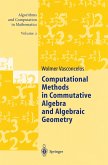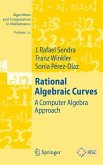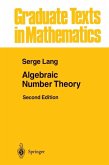A description of 148 algorithms fundamental to number-theoretic computations, in particular for computations related to algebraic number theory, elliptic curves, primality testing and factoring. The first seven chapters guide readers to the heart of current research in computational algebraic number theory, including recent algorithms for computing class groups and units, as well as elliptic curve computations, while the last three chapters survey factoring and primality testing methods, including a detailed description of the number field sieve algorithm. The whole is rounded off with a description of available computer packages and some useful tables, backed by numerous exercises. Written by an authority in the field, and one with great practical and teaching experience, this is certain to become the standard and indispensable reference on the subject.
With the advent of powerful computing tools and numerous advances in math ematics, computer science and cryptography, algorithmic number theory has become an important subject in its own right. Both external and internal pressures gave a powerful impetus to the development of more powerful al gorithms. These in turn led to a large number of spectacular breakthroughs. To mention but a few, the LLL algorithm which has a wide range of appli cations, including real world applications to integer programming, primality testing and factoring algorithms, sub-exponential class group and regulator algorithms, etc ... Several books exist which treat parts of this subject. (It is essentially impossible for an author to keep up with the rapid pace of progress in all areas of this subject.) Each book emphasizes a different area, corresponding to the author's tastes and interests. The most famous, but unfortunately the oldest, is Knuth's Art of Computer Programming, especially Chapter 4. The present book has two goals. First, to give a reasonably comprehensive introductory course in computational number theory. In particular, although we study some subjects in great detail, others are only mentioned, but with suitable pointers to the literature. Hence, we hope that this book can serve as a first course on the subject. A natural sequel would be to study more specialized subjects in the existing literature.
With the advent of powerful computing tools and numerous advances in math ematics, computer science and cryptography, algorithmic number theory has become an important subject in its own right. Both external and internal pressures gave a powerful impetus to the development of more powerful al gorithms. These in turn led to a large number of spectacular breakthroughs. To mention but a few, the LLL algorithm which has a wide range of appli cations, including real world applications to integer programming, primality testing and factoring algorithms, sub-exponential class group and regulator algorithms, etc ... Several books exist which treat parts of this subject. (It is essentially impossible for an author to keep up with the rapid pace of progress in all areas of this subject.) Each book emphasizes a different area, corresponding to the author's tastes and interests. The most famous, but unfortunately the oldest, is Knuth's Art of Computer Programming, especially Chapter 4. The present book has two goals. First, to give a reasonably comprehensive introductory course in computational number theory. In particular, although we study some subjects in great detail, others are only mentioned, but with suitable pointers to the literature. Hence, we hope that this book can serve as a first course on the subject. A natural sequel would be to study more specialized subjects in the existing literature.
H. Cohen A Course in Computational Algebraic Number Theory "With numerous advances in mathematics, computer science, and cryptography, algorithmic number theory has become an important subject. Undoubtedly, this book, written by one of the leading authorities in the field, is one of the most beautiful books available on the market."
-ACTA SCIENTIARUM MATHEMATICARUM
-ACTA SCIENTIARUM MATHEMATICARUM
From the reviews:
H. Cohen
A Course in Computational Algebraic Number Theory
"With numerous advances in mathematics, computer science, and cryptography, algorithmic number theory has become an important subject. Undoubtedly, this book, written by one of the leading authorities in the field, is one of the most beautiful books available on the market."
-ACTA SCIENTIARUM MATHEMATICARUM
"This book is intended to provide material for a three-semester sequence, introductory, graduate course in computational algebraic number theory. ... The book is excellent. ... The book has 75 sections, making it suitable for a three-semester sequence. There are numerous exercises at all levels ... . The bibliography is quite comprehensive and therefore has intrinsic value in its own right. ... chapters bring the student to the frontiers of the field, covering elliptic curves, modern primality testing and modern factoring methods." (Russell Jay Hendel, The MathematicalAssociation of America, January, 2011)
H. Cohen
A Course in Computational Algebraic Number Theory
"With numerous advances in mathematics, computer science, and cryptography, algorithmic number theory has become an important subject. Undoubtedly, this book, written by one of the leading authorities in the field, is one of the most beautiful books available on the market."
-ACTA SCIENTIARUM MATHEMATICARUM
"This book is intended to provide material for a three-semester sequence, introductory, graduate course in computational algebraic number theory. ... The book is excellent. ... The book has 75 sections, making it suitable for a three-semester sequence. There are numerous exercises at all levels ... . The bibliography is quite comprehensive and therefore has intrinsic value in its own right. ... chapters bring the student to the frontiers of the field, covering elliptic curves, modern primality testing and modern factoring methods." (Russell Jay Hendel, The MathematicalAssociation of America, January, 2011)

